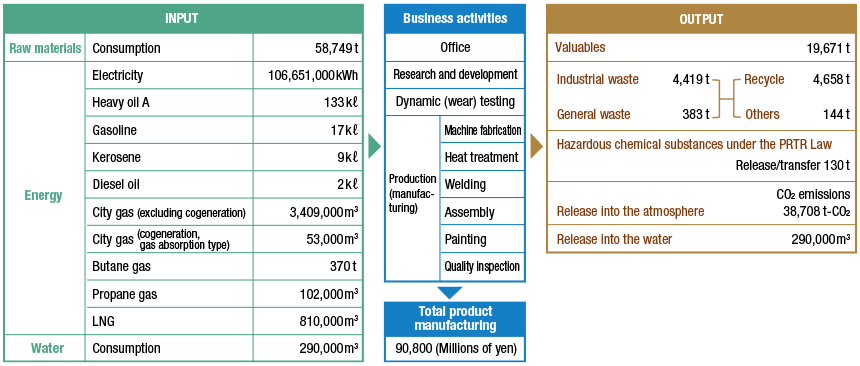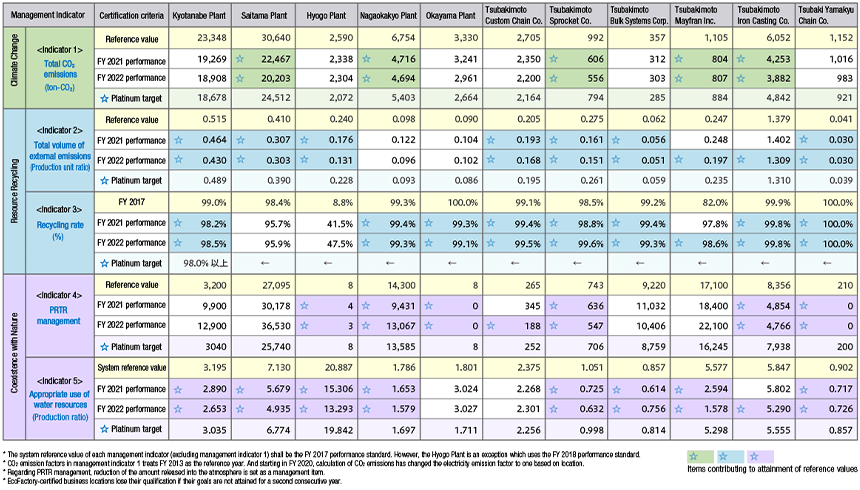Environmental Performance (FY 2022)
Material Flow Chart
The Tsubaki Group understands the impact on the environment of its business activities and strives to reduce its environmental impact. The results of the efforts of our 11 business locations in Japan in the fiscal year ended March 31, 2023, are presented below.

Implementing business sites:
Tsubakimoto Chain (Kyotanabe Plant, Saitama Plant, Hyogo Plant, Nagaokakyo Plant, Okayama Plant)
Tsubakimoto Custom Chain, Tsubakimoto Sprocket, Tsubakimoto Bulk Systems, Tsubakimoto Mayfran, Tsubakimoto Iron Casting, and Tsubaki Yamakyu Chain
Implementing period:
April 1, 2022 to March 31, 2023
Environmental Accounting
In order to protect the environment in an efficient manner, we quantify our investments and development costs and benefits at our business locations in Japan using classifications indicated in guidelines prepared by Japan’s Ministry of the Environment. We are engaged in a major effort to develop SDG-oriented products with an eye on global environmental conservation and are proactively working to seize business opportunities that will contribute to an improved social environment. In addition, to reduce CO2 emissions at our business locations, we are strengthening our initiatives targeting global environmental conservation by increasing the eco-friendliness of our various facilities.
The Tsubaki Group uses its environmental accounting system to analyze the cost of environmental conservation and the economic and ecological benefits obtained through environmental conservation activities. This information will be subject to disclosure and will also be utilized in future activities.
Environmental Conservation Costs
Target: 11 domestic sites
| Category | Details of Principal Initiatives | Investments | Expenses | |
|---|---|---|---|---|
| (1) Business area costs | 195,762 | 631,539 | ||
| Breakdown | (1)-1 Pollution control costs | Introduction and operational management of air pollution control facilities and wastewater treatment facilities | 53,513 | 244,043 |
| (1)-2 Environmental conservation costs | Introduction and operational management of power management system | 142,249 | 198,318 | |
| (1)-3 Resource recycling costs | Waste disposal and recycling costs; improvements to industrial waste storage facilities | 0 | 189,179 | |
| (2) Upstream and downstream costs | Analysis outsourcing costs, including those of substances with an environmental impact | 0 | 0 | |
| (3) Administration costs | Establishment and operation of EMS; improving the greening of worksite; installation of equipment for measuring air and water quality | 3,988 | 355,126 | |
| (4) R&D costs | Research and development of environmentally friendly products (reducing environmental impact during product use) | 15 | 622,736 | |
| (5) Social activity cost | Regional environmental activities | 0 | 0 | |
| (6) Environmental remediation costs | Purification of groundwater and the like | 0 | 0 | |
| Total | 199,764 | 1,609,402 | ||
Benefits for Environmental Conservation
| Category | Environmental Performance Indicator (Unit) | FY 2021 | FY 2022 | Difference from Reference Period (Benefits for Environmental Conservation) |
|---|---|---|---|---|
| Conservation benefits related to environmental impact and waste emissions from business operations | Total CO2 emissions (ton-CO2) | 61,372 | 38,708 | Decrease of 22,664 ton-CO2 |
| Waste emissions (tons) | 5,120 | 4,802 | 318-ton reduction | |
| Environmental conservation benefits from investing resources in business operations | Water (1,000 m3) | 312 | 290 | Reduction of 22,000 m3 |
EcoFactory Certification System
The Group recognizes that responding to the threat of climate change (by reducing CO2 emissions), acknowledged as an urgent environmental challenge, is a sufficient condition for an environmentally advanced company. It also recognizes that waste reduction, appropriate management of hazardous chemical substances, and other resource recycling efforts—along with the pursuit of greater harmony with nature through greening and water conservation—are necessary conditions for an environmentally advanced company.
Against this backdrop, in FY 2018 we established the EcoFactory Certification System for our business locations in Japan. This initiative encompasses management indicators and milestones for each of the three theme areas—climate change, resource recycling, and coexistence with nature—with the goal of steadily achieving our long-term environmental targets for the year 2030. In FY 2021, we revised our CO2 emissions certification criteria to coincide with the Tsubaki Group CO2 emissions reduction targets.
FY 2022 EcoFactory Certification
- Sapphire Rating (★★) Tsubakimoto Sprocket
- Platinum Rating (★) Tsubakimoto Mayfran, Tsubakimoto Iron Casting
EcoFactory Certification Criteria
| Theme | Management Indicator | Certification Criteria | |||
|---|---|---|---|---|---|
| ★ | ★★ | ★★★ | |||
| Platinum | Sapphire | Diamond | |||
| Climate Change | (1) | Total CO2 emissions from business activities (compared to FY 2013) | 20% reduction | 30% reduction | 46% reduction |
| Resource Recycling | (2) | Total external emissions (per unit of production compared to FY 2017) | 5% reduction | 10% reduction | 15% reduction |
| (3) | Total waste recycling rate | More than 98% | More than 98.5% | More than 99% | |
| Coexistence with Nature | (4) | Reduction in atmospheric emissions of substances subject to PRTR (compared to FY 2017) | - | 5% reduction | 10% reduction |
| (5) | Improved greening rate of plants | - | At least 2% pts above each municipality's standard | At least 4% pts above each municipality's standard | |
| (6) | Effective use of water resources | - | 5% reduction | 10% reduction | |
[The following must be met as necessary conditions for certification]
- No conflict with environmental laws and ordinances
- No indication of Category A in the external review of ISO14001
- No environment-related complaints from local residents, or any such complaints have been resolved
FY 2022 Environmental Data for Business Locations in Japan
The environmental data for domestic sites based on the EcoFactory Certification target items are as follows:




